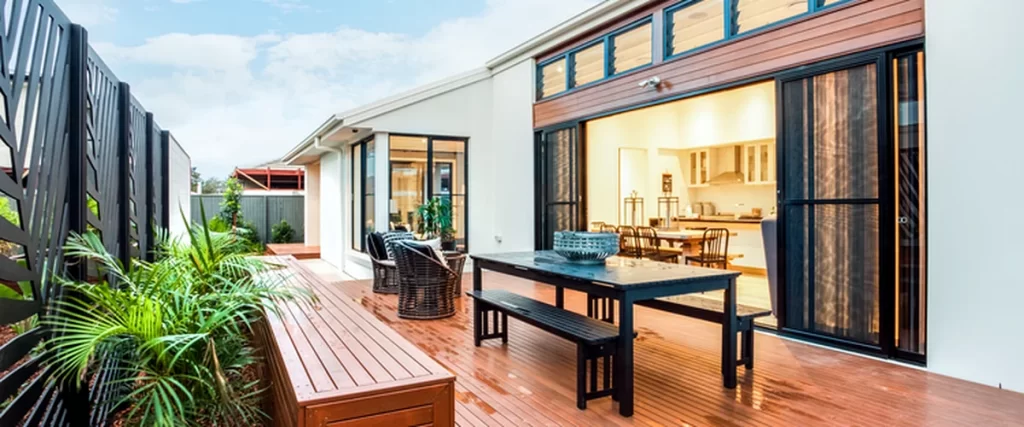A deck can add comfort, beauty, and extra living space to any home, but it also carries responsibilities.
Every year, decks in Lincoln face heavy rain, snow, and temperature changes that slowly wear down materials. Over time, even a well-built structure can weaken if it isn’t maintained or checked regularly. A simple inspection can make a big difference in ensuring safety and keeping your outdoor space strong for years.
Homeowners often focus on the look of their decks, like the stain color, the railings, and the furniture. But safety is what allows those design choices to matter. Knowing how to evaluate your deck’s condition and ensure compliance with local building codes protects your loved ones and helps you avoid costly repairs later.
The following checklist covers the most important parts of deck safety in Lincoln.

1. Start With the Structure
The structure supports everything above it, so it’s the first place to look when checking your deck. The posts, beams, and joists carry the weight of furniture, people, and snow. If any of these parts are damaged, loose, or decayed, the entire deck may be at risk.
Here’s what to look for:
- Rot or insect damage on posts or beams.
- Cracked or splitting wood, especially where fasteners meet the surface.
- Rusting hardware or bolts that no longer feel tight.
- Sagging or uneven boards can signal hidden water damage.
Moisture is a major enemy in Nebraska’s climate. Sealing or staining the wood every few years helps prevent water from entering, extending the life of the deck. Homeowners who prefer low-maintenance options often choose composite materials for durability and longer lifespan.
2. Examine the Railings and Stairs
Railings and stairs are central to deck safety. They provide stability and prevent falls, especially when children or older family members are present. Lincoln’s local building codes specify railing height requirements and spacing between balusters.
You should check:
- The height of your railings meets local code requirements.
- All railings feel secure with no wobbly sections.
- The baluster spacing prevents small children from slipping through.
- Stair handrails are sturdy and properly anchored.
- The stair treads are even and not pulling away from the structure.
If you’re unsure about your railing’s compliance, a contractor familiar with Lincoln’s building codes can evaluate the setup and make recommendations. Replacing outdated railings can enhance safety while improving your deck’s overall look.
3. Inspect the Deck Surface
The surface experiences the most daily wear. It’s also the part most homeowners see and use. Water, sunlight, and foot traffic all play a role in breaking down the boards over time.
When inspecting the surface:
- Walk across the deck and feel for soft spots or bounce that might indicate rot underneath.
- Look for cracked or warped boards that could cause trips or splinters.
- Ensure the fasteners sit flush with the surface and haven’t popped up.
- Check for water pooling after rain, a sign that sealing or drainage may need improvement.
Regular deck staining or sealing protects the surface from moisture and UV rays. This small maintenance step can prevent expensive repairs later. A professional contractor can recommend finishes suited to Nebraska’s weather and your deck’s material type.

4. Check the Ledger Board
The ledger board is the beam that connects your deck to the house. It’s one of the most essential parts of the structure, as it supports the deck’s outer edge. A weak or improperly installed ledger board is one of the most common causes of deck failure.
Confirm that:
- The flashing (metal or plastic barrier) is intact and preventing water from seeping behind the board.
- The bolts or lag screws are tight and free of rust.
- The wood behind the ledger is solid with no signs of rot or mold.
Never attach a ledger board with nails alone; they cannot hold the same weight as bolts.
5. Assess the Foundation and Ground Contact
The base of your deck determines its overall stability. Posts that shift or sink can cause the entire structure to lean. Lincoln’s soil and weather patterns make it important to ensure proper drainage around the deck.
When reviewing the foundation:
- Verify that posts rest on concrete footings rather than directly in the soil.
- Make sure there’s no standing water around the base, which can cause rot.
- Look for signs of erosion or frost heave that might affect support.
Proper planning during deck construction helps prevent these issues, but they can still develop over time. Regular inspection and quick repairs can prevent long-term damage.
6. Confirm Compliance With Local Building Codes
Deck safety depends heavily on following local deck building codes. These codes define height limits, railing dimensions, weight requirements, and spacing between structural elements. Even small differences in measurements can affect compliance.
For a new deck construction, homeowners must obtain a building permit from the city. This ensures that your design meets safety regulations and passes inspection once complete.
Working with a contractor familiar with Lincoln’s local deck building code requirements makes the process smoother. They’ll handle the paperwork, confirm all specifications, and make sure your project stays compliant from start to finish.
7. Review Weight and Usage
Every deck is designed to hold a specific amount of weight, including furniture, people, and accessories like planters or hot tubs. Exceeding that weight can cause stress on the structure, leading to cracks or sagging.
To maintain safety:
- Review the weight capacity for your deck’s design.
- Avoid placing heavy items in one area, such as large grills or water features.
- Distribute furniture evenly across the space.
If you’re adding new features like a pergola or hot tub, consult your contractor to verify that the deck’s support system can handle the load.
8. Look for Signs of Water Damage
Lincoln’s climate makes decks vulnerable to moisture. Snow, rain, and humidity can lead to hidden problems if water isn’t draining correctly. Over time, water damage can weaken supports, corrode hardware, and discolor surfaces.
You can prevent water damage by:
- Cleaning the deck regularly to remove debris that traps moisture.
- Sealing or staining the wood every few years.
- Inspecting gutters or rooflines to make sure runoff doesn’t pour directly onto the deck.
A small maintenance habit like resealing once a year can extend your deck’s life and keep it safe.
9. Pay Attention to Fasteners and Hardware
Bolts, nails, and brackets may seem minor, but they’re vital to the deck’s stability. Rusting or loose hardware can compromise safety even if the wood appears strong.
During your inspection:
- Replace any rusted nails or screws with corrosion-resistant materials.
- Make sure metal brackets and connectors are securely fastened.
- Tighten loose bolts, particularly around the railing and stair areas.
A professional inspection includes checking these small but significant details to ensure compliance with the deck building codes.
10. Call the Experts When in Doubt
Even with a detailed deck project checklist, some problems aren’t visible without professional tools and experience.
Deck contractors can spot early signs of deterioration that homeowners might miss. They understand the construction process, know local codes, and can guide you through any repairs or replacements that keep your deck safe and compliant.
An experienced team ensures the job meets Lincoln’s building codes, improves the deck’s durability, and enhances its appearance. They also handle details like obtaining permits and verifying specifications before construction begins, saving you time and preventing setbacks.
Why Deck Safety Matters
Protecting the people who gather on your deck is the most important part of any deck project. A well-built, properly maintained deck gives you confidence in every step you take on it. It also adds value to your home and ensures that your outdoor space remains inviting for years.
Homeowners who prioritize safety tend to spend less on repairs later and enjoy a deck that looks and feels solid season after season.

Let Professionals Handle the Hard Work
Regular inspections, compliance with codes, and ongoing maintenance can be time-consuming. Many homeowners prefer to have an experienced contractor handle the process from start to finish.
Professionals understand how to identify structural issues, prevent water damage, and bring every part of a deck up to current safety standards.
If you’d rather focus on enjoying your outdoor space instead of worrying about technical details, our team is ready to help. We take pride in creating decks that look beautiful, stay compliant, and last through Nebraska’s toughest weather.
If you’re planning your next project or need help inspecting your current deck, call us at (402) 369-5724 or message us here to schedule your safety evaluation. Our deck building experts will ensure your deck is secure, compliant, and ready for many more years of use.
